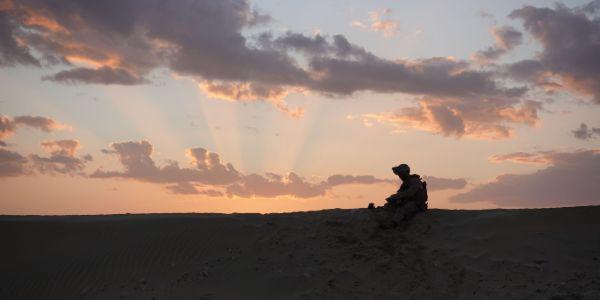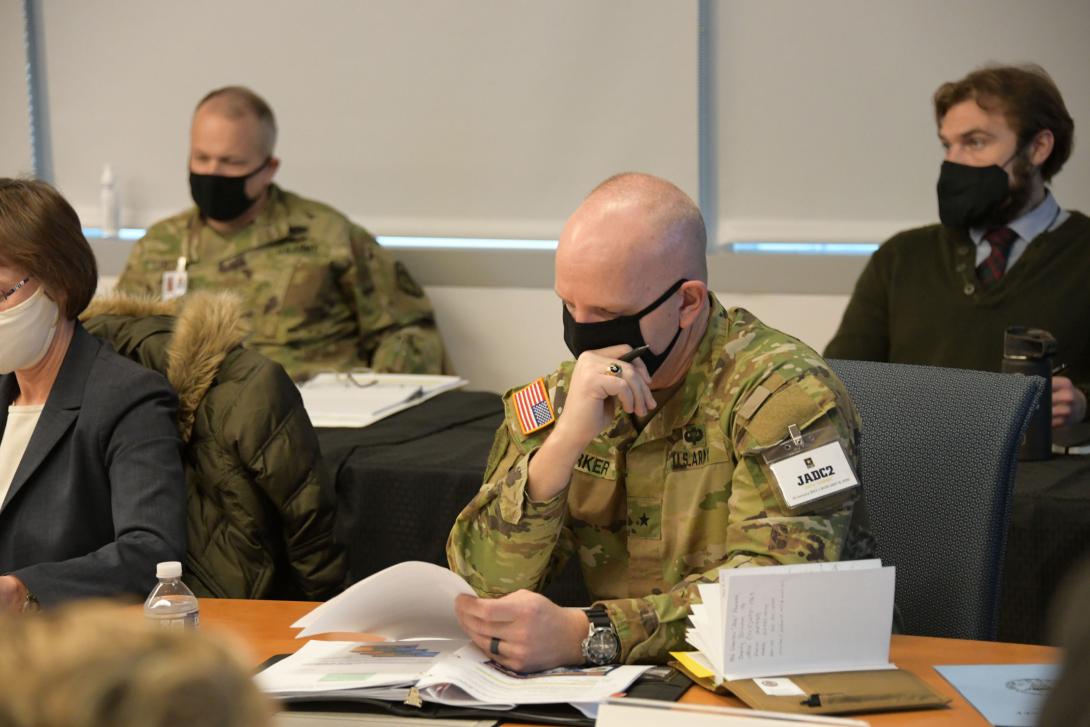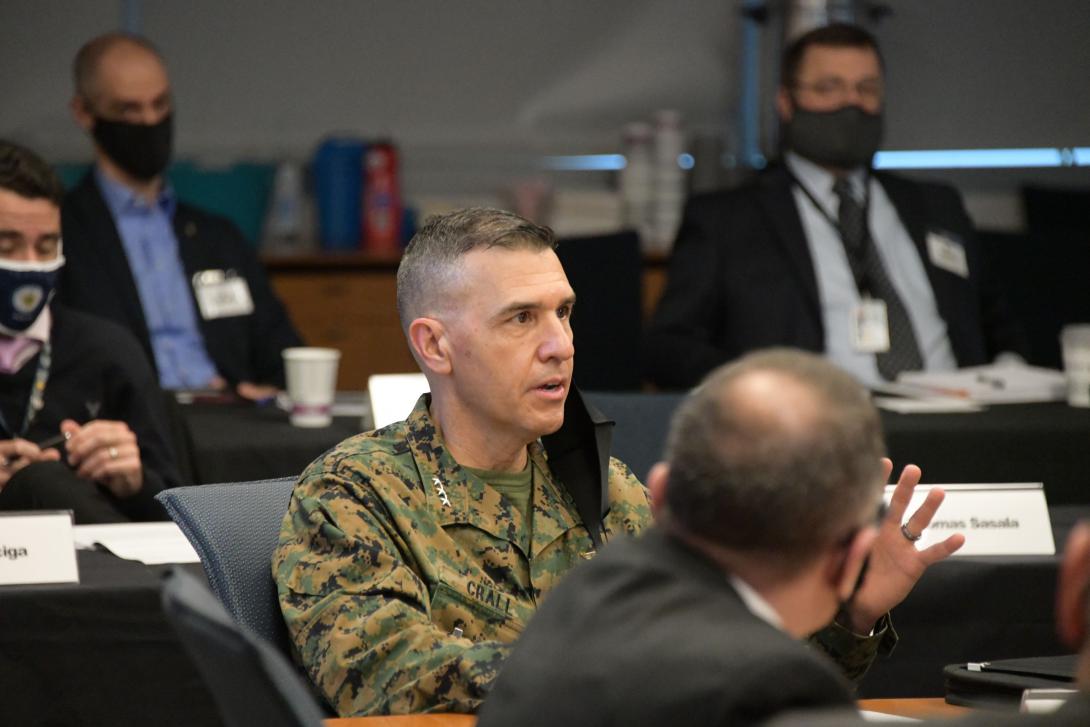Services Choose Independent Paths for JADC2
The U.S. military services are meeting the challenge of upgrading without losing needed capabilities as they march toward the goal of a common command and control system. By focusing on this approach, they are positioning themselves for convergence under an all-encompassing strategy formulated by The Joint Staff. In effect, their efforts represent a devolution from multiple branches to a single outcome that will unify all elements of the military.
The Defense Department spent the past year experimenting with the integration of systems to enable Joint All-Domain Command and Control, known as JADC2. However, the department lacked a clear strategy from top leadership to accomplish JADC2, observes Lt. Gen. Dennis Crall, USMC, director, Command, Control, Communications and Computers/Cyber; and chief information officer, The Joint Staff (J-6).
Codifying JADC2 strategy has been one of Gen. Crall’s early goals since he took his position last November. “It became very apparent in my first few days on the job that we did not have strategy that we could use as our anchor point or stripe on the road to determine where we are in our progress of bringing order to all these good efforts and activities that the services, the combatant commands and our joint partners are doing,” Gen. Crall says. “It was really hard to find design and purpose, and if you can’t find design and purpose, then it’s very difficult to budget against that and put the right benchmarks in place and answer the proverbial question of, ‘Are we on track?’”
This strategy is necessary because each of the services is pursuing JADC2 within their own constructs. This allows each to continue to provide vital command and control (C2) services in their own mission areas without suffering a loss of capability. But also, it allows each service to contribute to JADC2 in specific areas of expertise.
“They each bring something incredibly unique. In some cases, they have the head start in certain areas, all of which I have found to be useful,” Gen. Crall offers.
For the Air Force, Gen. Crall cites the work it has done on the Advanced Battle Management System (ABMS). “The sensor-to-shooter solutions and the pilots that they have worked have widespread value to others who are trying to forge that same road.
“The Air Force’s approach has, in some cases, been with more pilot systems,” he continues. “They’ve invested in some really new gear, some radios, some gateways. They’re using cloud in a very unique way, which is very encouraging. So I welcome all of it.”
The J-6 also cited the Army’s work with its many C2 assets. “The Army is taking a lot of disparate systems—legacy systems along with modern systems—and finding a way to bring them together without, in some cases, new investments or really significant re-engineering.
“They have actually demonstrated—not just in the lab but also in the real world—how to bring these things together and show, for example, a common operating picture in some aspects,” he states. Gen. Crall adds that the Army has done a good job in bringing in the intelligence community in ways that the other services have not.
The Navy also comes in for praise, particularly for its operational readiness. “They absolutely practice and expect to go to war in an extremely contested information environment, where the electromagnetic spectrum is almost all but taken completely away,” he declares.
Yet all these independent efforts bring up the need for the overall JADC2 strategy. “We don’t have a particular leader that appears more valuable than anyone else,” he states. “But while all of these on the front edge are exciting and welcome, you might imagine without discipline or direction we could find ourselves a year or two from now in some very different kits that no longer would I view contributing to a common approach. It won’t take long to go awry if we’re not careful, so I think this is why the strategy brings these folks together and answers some of their fundamental questions about keeping this momentum going in a way that can be useful across all services in a combined and joint fight.”
So far, the JADC2 strategy has gone through two iterations: first, through a coordination process with the Joint Staff and then to the individual services and combatant commands for input. “We got great feedback,” the J-6 notes.
The strategy first identified about a dozen or so lines of effort, some of which will be consolidated or identified as major or minor—but not less important—areas
Data is one of the critical areas of the strategy, the general said. “Data, and the pursuit of a common data fabric will be a logical line of effort,” Gen. Crall explained. “This entire machine runs on data and how data is configured, how we use data, how we distribute data and how we safeguard data is going to certainly be a central theme.”
In late January, to advance the discussion on JADC2-related information sharing, Gen. Crall, along with Dave Spirk, chief data officer of the Defense Department, held the first in a series of JADC2 data summits—and will hold another such meeting in April. They were joined by the military’s other chief data officers, data scientists, subject matter experts and officials from the department, the joint force, defense agencies, the services, the U.S. combatant commands, the intelligence community, the Department of Homeland Security and NATO, the general says.
“The summit served as a great starting point and the ideal event to posture us to measure our data readiness and to set in place the prioritized tasks and milestones needed to achieve our time-sensitive outcomes,” Gen. Crall states. “[It] was critical to starting the challenging work of developing the required governance, data management practices and associated architecture required to ensure the full functionality of the JADC2 ecosystem.”
The group focused on defining the concept of a data fabric for the JADC2 environment, which will be the foundation for the joint force’s employment of algorithms and applications to process data at the speed of relevance, the J-6 adds. “While the JADC2 strategy provides both the why and the desired future state, the data summit helped us rationalize and define the data fabric, the means to our JADC2 decisional advantage,” he says.
In addition to data, another important aspect of the JADC2 strategy involves the Defense Department’s mission partner environment, or MPE, effort, Gen. Crall relates. As operations in a joint all-domain environment involve allies and partners more and more, the JADC2 strategy has to address how countries share information. Part of the process of multinational information sharing, the MPE provides a federated networking structure to apportion data and information between allied countries during operations or exercises.
“We are building in a mission partner environment as part of the organic conversation, not as an afterthought or a bolt-on later,” the general emphasizes. “We expect it to be a little more challenging, but we also know that we need it. It allows us to bring our partners in as we form what this looks like for the kind of fight we expect.”
The JADC2 strategy also includes a line of effort regarding the U.S. nuclear command, control, and communications (NC3) system. How the command and control of nuclear operations is conducted in relation to joint warfighting across all domains has to be addressed. Naturally, since NC3 is a national security issue and a classified topic, the general could not go into much more detail. “You might not be surprised to learn that NC3 has a level of treatment in the strategy,” he confirms.
As for how The Joint Staff will assign primary responsibility for the JADC2 lines of effort across the Army, Air Force, Marine Corps, Navy and Space Force, Gen. Crall explains that it will stem from some aspects of the Joint Warfighting Concept, or JWC. That concept, in development over the past year, guides the Defense Department’s globally integrated operations and drives the development of joint-concept, threat-informed capabilities. The JWC also provides a unity of effort for force development and design.
“Part of the confusion has been the understanding of what transfers from the Joint Warfighting Concept into JADC2,” he says. “The Joint Warfighting Concept has been divided by giving each of those supporting concepts a service lead. For example, the Air Force is the service lead for the Joint Cyber Command and Control, or JCC2, aspect, and they are doing great work. When it comes to JADC2, however, it becomes a much broader ecosystem; much, much bigger; much more complex; and with far more stakeholders involved than the original Joint Warfighting Concept. Each of those lines of effort will have sub-objectives and those sub-objectives will have OPRs [offices of primary responsibility] assigned, and that bidding process will be worked through the Joint Staff.”
The J-6 and other leaders will discuss JADC2 assignment recommendations with the vice chairman, Gen. Crall notes. “Some of it will be decided at the vice’s level with some discussion,” he clarifies. “Some of these are already so naturally aligned to ownership that it will be a light lift and an easy transition. Other lines of effort have multiple statements, and those decisions will have to be made on a series of arguments on those best suited to deliver them, balanced with equity and just distribution.”
He reiterates that the JADC2 Cross Functional Team (CFT) will continue to serve an essential role in hashing out concepts and solutions for joint all-domain operations. “The CFT has been operating for some time now and is really the most advantageous entry point for those who want to ensure that their fingerprints are on the output of what not only the document has to say but also the delivery of capabilities that come as a result,” Gen. Crall says. “The CFT is positioned right now not as a waning star but one that is actually being reorganized and growing, both in influence and in size.”
Moreover, the strategy will help the Defense Department effectively align its work in JADC2, which needs to be successful given what is at stake in a near-peer competitive environment. “It is not as though we were heading off in some errant direction and now this is a rapid turn,” the J-6 shares. “This is about fine-tuning that machine and onboarding the goodness, for example that the Air Force is doing in ABMS. Every bit of that work they are doing has a complete home inside of JADC2. The same work the Army is doing in Project Convergence and the Navy in Project Overmatch and even some of the discreet work that the Marine Corps is doing, all of it has a place. And the reason timing is important is if we don’t solidify our road map and the way ahead, what are good ideas and are working now in a common purpose may not be that way in a year or two from now. That level of divergence, if we are off-kilter or are not working in concert with each other, could really manifest itself in adding years in ways that make it more difficult to recover.”
Gen. Crall emphasizes that now is the time to ensure that the long-term goal is met by the work in each service. Even well-intentioned development could lead the force astray, and the Defense Department wants to avoid passing the tipping point where the strides made by each service go past the ability to bring about their convergence.
“We’re probably closer to that [tipping point] than we think, but I don’t doubt that we will be able to ensure that our efforts align quite nicely,” he declares. “We’ve got good momentum and we’re on a good pace to get this document out.”






Comments